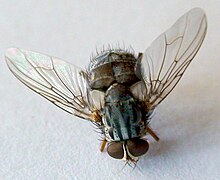
The Calliphoridae are a family of insects in the order Diptera, with almost 1,900 known species. The maggot larvae, often used as fishing bait, are known as gentles. The family is known to be polyphyletic, but much remains disputed regarding proper treatment of the constituent taxa, some of which are occasionally accorded family status.
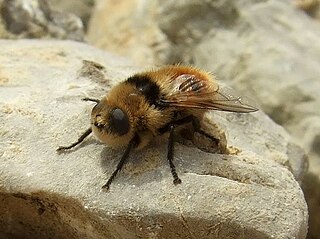
Botflies, also known as warble flies, heel flies, and gadflies, are a family of flies known as the Oestridae. Their larvae are internal parasites of mammals, some species growing in the host's flesh and others within the gut. Dermatobia hominis is the only species of botfly known to parasitize humans routinely, though other species of flies cause myiasis in humans.
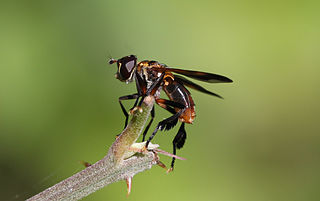
Trichopoda is a genus of tachinid flies, commonly known as the feather-legged flies or hairy-legged flies. They are small, brightly coloured flies that congregate on flowers, feeding on nectar. The halteres are covered with yellow scales and there is a fringe of flattened hairs on the hind legs. The larvae are parasitoids of true bugs in the order Hemiptera, including stink bugs in the family Pentatomidae and leaf-footed bugs and squash bugs in the family Coreidae. They are found in North and South America.

The Galápagos mockingbird is a species of bird in the family Mimidae. It is endemic to the Galápagos Islands, Ecuador.
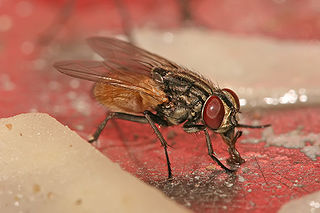
Muscini is a Tribe of flies from the family Muscidae.
Houghia is a genus of flies in the family Tachinidae.
Calodexia is a Neotropical genus of parasitic flies in the family Tachinidae. Females follow columns of army ants, apparently waiting for cockroaches to be flushed from hiding.
Celatoria is a genus of flies in the family Tachinidae. Larvae are parasitoids of leaf beetles.
Chrysotachina is a genus of flies in the family Tachinidae.
Euhalidaya is a genus of flies in the family Tachinidae.
Eucelatoria is a genus of flies in the family Tachinidae.
Lespesia is a genus of flies in the family Tachinidae.
Lixophaga is a genus of flies in the family Tachinidae.

The Mydaeinae are a subfamily of true flies, belonging to the family Muscidae.

Philornis downsi, also known as the avian vampire fly, is a species of fly that was first recorded in Trinidad and Brazil in the 1990s. It has been accidentally introduced to the Galapagos Islands (Ecuador). Adults of P. downsi feed on fruit. Eggs are laid in bird nests and hatch into parasitic larvae that reside in the nest material and emerge at night to feed both internally and externally on the blood and flesh of developing nestlings. The parasite causes significant mortality in Darwin's finch nestlings and threatens the survival of some rarer species such as the mangrove finch and the medium tree finch. To protect the threatened finch populations, insecticide-laced cotton has been supplied as nesting material for the finches, with the results being highly successful in combating P. downsi infestations at a localized scale. Currently, Biological pest control agents, including Conuraannulifera, are being investigated for their potential safety and efficacy in eradicating P. downsi on the Galapagos Islands.
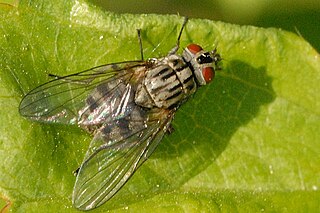
Reinwardtiini is a tribe of flies from the family Muscidae.
The Cyrtoneurininae are a subfamily within the Diptera family Muscidae.

Exoristinae is a subfamily of flies in the family Tachinidae. Most species are parasitoids of caterpillars.
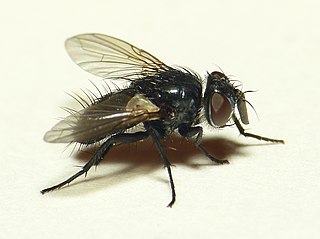
Blondeliini is a tribe of parasitic flies in the family Tachinidae. Larvae are parasitoids of other insects, mostly beetles and caterpillars. Although nearly cosmopolitan, its greatest diversity is in the New World and especially in South America.
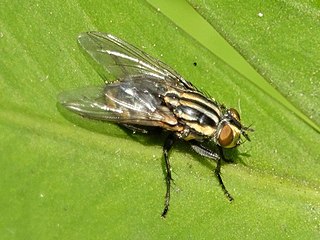
Oxysarcodexia is a genus of flies belonging to the family Sarcophagidae.
